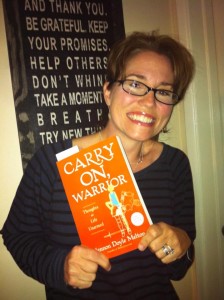
?
To be fair, it was only the ?ess-word?. ?I mean, it?s not like I flashed the EFF or SEE words. And it was a total accident that, of course, caused an eruption of hearty laughter?.in Sugar Bean?s 7th grade, Advanced English class last Thursday.
You see, after Sugar Bean oh so proudly told her teacher that I write a blog, she began following, and then asked me to come and speak about the benefits of good grammar skills in everyday life, the advantages of having an English degree, and the blessing that came from writing my thoughts down right here and having them turn into a job. That pays. A little ![]()
Anyway, I was delighted to go in and speak to the students. I?ve never been asked to do such a thing. Of course, that could be because I?ve only had a blog for a little over a year, and it?s hardly proper for the under 12 crowd, don?t ya think? So I prepared ahead of time, decided the key points to talk about, and then chose 3 posts to read aloud. Sugar Bean helped in the selection process. If you would like to read the selected posts. They are here, here and here. I had planned to read this one?also, but got completely flustered after ?Cold Turkey? popped up onscreen while I was searching for ?Good Morning, Radio Listeners?. (wtf is that about?) I had all the selected posts pulled up in different tabs on my laptop, so I could easily navigate from piece to piece, but God decided to laugh at my technical preparedness, and throw me out of sync. In other words, I couldn?t project the screen of my laptop onto the wall of the classroom. Not for lack of trying though! Luckily, my blog isn?t blocked on the school?s server (although I?d throw?down a heavy bet in Vegas it is now) and we were able to use Mrs.W?s computer. Short on time, and not really remembering how to open a new window on a PC, I decided the best way to find each post quickly was to simply search. BAD IDEA. After reading the first post, I typed in the keywords for the next one into the SEARCH BOX, and was taken to a post accompanied by an image with a caption containing the ?ESS? word. Oh, and the background was bright yellow, as not to be missed. ?Of course, the projector was working very well that day. ?GO ME, right??
Fortunately, the class was only exposed to it long enough to read it, and react with roars of laughter. Once I realized it was there, I scrolled down and pulled it from view. Then I scrolled back up by accident 2 or 3 more times, inciting more hysterics. So, I?m oh for three now.
Oh well. The road to Hell is paved with good intentions. Or at least that?s what Mama always said 
All in all, it was a very good day. I never lost their attention, and believe they genuinely enjoyed what I had to say. The word on the street is they told Sugar Bean I was pretty, and thought I was younger than I am. That?s ALWAYS a plus! They may have even learned a thing or two, who knows? A couple of the students had questions, and although I didn?t have time to discuss them in class, I want to now.
The first question is: ?Do you blog everyday???
The obvious answer to this is NO. However, I do write everyday. I keep a journal in my purse, and I am constantly jotting things down in it for publication later. At any given moment, my brain has 8 gazillion thoughts running through it and it?s necessary to record?the ones that shine. Or else they will be gone forever?lol. I want to blog everyday, eventually. But honestly, if I put down ALL my thoughts and adventures here?.someone would show up at my door and fit me for a nice jacket and room with padded walls. So I?ll just stick to publishing the important stuff. For now.?
The other question is: ?Do you want to write a book one day???
OMG, yes. That?s a dream of mine, and honestly, I didn?t know it was a dream until I started writing. That?s years down the road though?I think. I?ve got so much more living and learning and storytelling left to do, right here on this blog before I have enough to make a whole book worth reading. As I discussed with the class, my soul-sister whom I?ve never met (but will very soon), Glennon Doyle Melton?the genius behind Momastery?has written a book. Due for release ?to the public on April 2nd. In a magical moment 2 weeks ago, I was contacted by TLC Book Tours about posting a review of her book, Carry On, Warrior, here on my blog. After I peed my pants, I enthusiastically accepted. The book arrived a few days ago?.

It?s REALLY here!
And I?m reading it?right now.
Thanks again, to Mrs.W, for making me feel like a ROCKSTAR by asking me to visit my Sugar Bean?s class. And thanks to the class for laughing at the inappropriate image your eyes were drawn to. That totally turned the day into a post ![]()
Source: http://calibamamom.com/2013/03/10/dedicated-to-the-writersbloggers-of-tomorrow/
the blaze Linda McMahon Voting Results 2012 pbs ron paul Cnn Electoral Map roseanne barr

 Oil dripping from a car can tarnish your driveway or garage floor, but it's easy to clean up with a some cola.
Oil dripping from a car can tarnish your driveway or garage floor, but it's easy to clean up with a some cola.